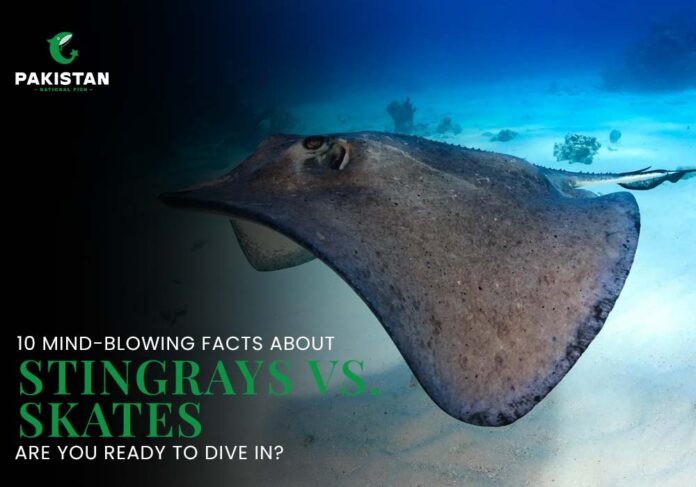Table of Contents

What Are Stingrays and Skates?
Stingrays and skates are cartilaginous fish, part of the class Chondrichthyes, which also includes sharks. Their skeletons are made of flexible cartilage rather than bone, giving them their signature flat, disc-shaped bodies. Both belong to the superorder Batoidea, but they diverge into different orders: stingrays in Myliobatiformes and skates in Rajiformes. These bottom-dwelling creatures are often mistaken for one another due to their similar appearances, but they have distinct characteristics that set them apart.
- Stingrays: Known for their venomous tail barbs, stingrays include about 220 species across eight families, such as Dasyatidae (whiptail stingrays) and Potamotrygonidae (river stingrays). The southern stingray (Hypanus americanus) is a well-known example.
- Skates: Skates, like the big skate fish (Beringraja binoculata), lack venomous barbs and have thorny projections instead. There are over 200 skate species, often found in deeper waters.
How Do Stingrays and Skates Differ?
Feature | Stingrays | Skates |
Tail | Long, whip-like with venomous barb | Short, thick with thorny spikes |
Teeth | Flat, plate-like for crushing | Small, pointed for grasping |
Reproduction | Viviparous (live birth) | Oviparous (lay eggs) |
Pelvic Fins | Single lobe | Two lobes |
Dorsal Fins | Absent or small | Small but distinct |
Scientific Order | Myliobatiformes | Rajiformes |
- Stingray Eyes and Mouth: Stingray eyes are on top of their bodies, while the sting ray mouth and gills are on the underside. This setup helps them hunt while buried in sand, using their ampullae of Lorenzini to detect prey’s electrical signals.
- Skate Anatomy: Skates, like the skate animal or skatefish, have similar eye and mouth placements but rely on thorny projections for defense, not venom.
What Are the Key Features of Stingrays?
Stingrays are oceanic superstars with unique traits that make them stand out. Here’s a breakdown of their defining features:
- Cartilaginous Skeleton: Like sharks, stingrays have flexible cartilage instead of bones.
- Flat Disc Shape Body: Their wide, flat bodies, like the bat stingray, help them glide and camouflage on the ocean floor.
- Venomous Tail: The barbed tail delivers venom, used for defense, not hunting. The southern ray is notorious for this.
- Bottom Dwelling: Stingrays spend much of their time buried in sand or mud, ambushing prey.
- Carnivorous: They feast on mollusks, crustaceans, and small fish.
- Viviparous: Stingrays give birth to live young, called pups, fully formed.
What Makes Skates Unique?
Skates, often called skateboarding fish for their gliding motion, have their own charm. Here’s what sets them apart:
- Thorny Defense: Instead of venomous barbs, skates have sharp, thorn-like projections on their backs and tails.
- Egg-Laying: Skates are oviparous, laying leathery egg cases known as “mermaid’s purses.”
- Deeper Habitats: While some stingrays live in shallow waters, skates often prefer deeper, colder environments.
- Smaller Size: Skates are generally smaller than stingrays, with the big skate fish being an exception, reaching up to 8 feet.
What Do Stingrays Eat?
What do stingrays eat? Stingrays are carnivorous, with a diet that includes:
- Crustaceans: Crabs, shrimp, and lobsters are favorites.
- Mollusks: Clams, oysters, and mussels are crushed with their plate-like teeth.
- Small Fish: They ambush small fish swimming near the ocean floor.
- Worms and Squid: Some species, like the pelagic stingray, include squid in their diet.
Stingrays use their sting ray mouth to suck in prey like a vacuum, aided by their electroreceptors. Their feeding habits make them key players in maintaining benthic ecosystems.
Where Do Stingrays and Skates Live?
Stingrays and skates inhabit diverse environments, from shallow coastal waters to deep ocean floors:
- Stingrays: Found in tropical and subtropical waters, including the southern stingray in the Atlantic and Caribbean. Freshwater species, like those in stingray stardew (inspired by river stingrays), live in rivers and lakes.
- Skates: Prefer colder, deeper waters, often at depths over 9,000 feet. The big skate fish thrives in the Pacific, from Alaska to California.
Both species are masters of camouflage, blending into sandy or muddy bottoms to avoid predators like sharks and seals.
How Do Stingrays and Skates Reproduce?
Reproduction is a major difference between these two:
- Stingrays: Viviparous, giving birth to live pups. For example, the southern stingray has an 11-month gestation period, producing one pup per cycle.
- Skates: Oviparous, laying eggs in “mermaid’s purses.” These cases protect the embryo for about 12 weeks until hatching.
During mating, male stingrays use their ampullae of Lorenzini to detect female signals, while skates rely on similar sensory cues. Neither provides parental care post-birth or hatching.
What Are Some Fascinating Facts About Stingrays?
- Here are 10 facts about stingrays that will blow your mind:
- Ancient Origins: Stingray fossils date back to the Jurassic period, 150 million years ago.
- Size Variety: From the 10cm short-nose electric ray to the 7m oceanic manta ray.
- Electric Rays: Some stingray species can generate electric shocks up to 220 volts for defense.
- Camouflage Experts: Their colors match the ocean floor, aiding in predator evasion.
- Social Fevers: Large groups, called “fevers,” can include up to 10,000 stingrays during migration.
- Venomous Defense: Their tail barbs deliver painful, sometimes fatal, venom.
- Sensory Superpowers: Stingray eyes may not hunt, but their electroreceptors are top-notch.
- Edible Wings: In some cultures, stingray wings are a delicacy, grilled or curried.
- Threatened Species: Overfishing and habitat loss endanger 107 ray species, per the IUCN Red List.
- Stingray City: In the Cayman Islands, divers can swim with friendly stingrays.
What’s the Deal with Stingrays Smiling?
How Do Squid and Stingrays Interact Ecologically?
The squid and stingrays ecological relationship is complex and fascinating:
- Predator-Prey Dynamics: Some stingrays, like the pelagic stingray, feed on squid, using their electroreceptors to locate them in the water column.
- Competition: Both compete for similar prey, like small fish and crustaceans, in overlapping habitats.
- Ecosystem Balance: Stingrays help control benthic populations, while squid influence mid-water ecosystems, creating a balanced food web.
This relationship highlights the interconnectedness of marine life, where each species plays a vital role.
What Are the Common Diseases and Cures for Stingrays vs. Skates?
Both stingrays and skates are susceptible to diseases, especially in captivity. Here’s a look at common issues and treatments:
- Bacterial Infections:
- Symptoms: Lesions, fin rot, or lethargy.
- Treatment: Antibiotics like oxytetracycline, administered via water or injection.
- Parasites:
- Symptoms: Skin irritation, weight loss, or visible worms.
- Treatment: Antiparasitic drugs like praziquantel or copper-based treatments (with caution).
- Fungal Infections:
- Symptoms: White patches or cotton-like growths.
- Treatment: Antifungal agents like malachite green, used in controlled doses.
- Ammonia Poisoning:
- Symptoms: Gasping, erratic swimming, or red gills.
- Treatment: Immediate water changes, maintaining ammonia/nitrite levels at 0, and using RO/DI water.
Magic Tip: Regular water testing and quarantine for new specimens can prevent outbreaks. For freshwater stingrays, maintain pH between 6.8–7.6 and temperature at 75–82°F.
FAQs
Different stingray types include:
- Southern Stingray: Coastal, venomous, diamond-shaped.
- Manta Ray: Filter-feeding giant, no sting.
- Electric Ray: Generates electric shocks.
- Blue-Spotted Stingray: Vibrant, venomous, tropical.
This blog has explored the captivating world of stingrays and skates, from their cartilaginous skeletons to their viviparous and oviparous reproductive strategies. Whether you’re intrigued by the southern stingray or the big skate fish, these creatures remind us of the ocean’s diversity.
Dive into their world, and you’ll never look at a “skateboarding fish” the same way again!


